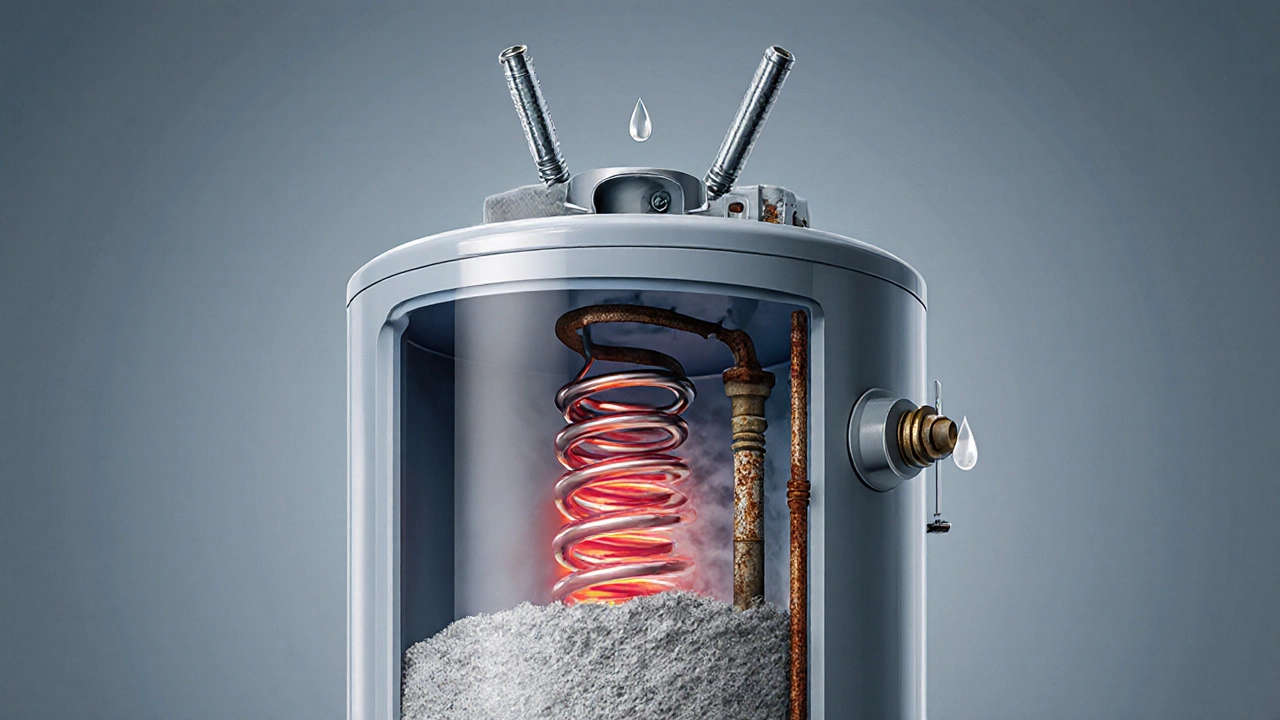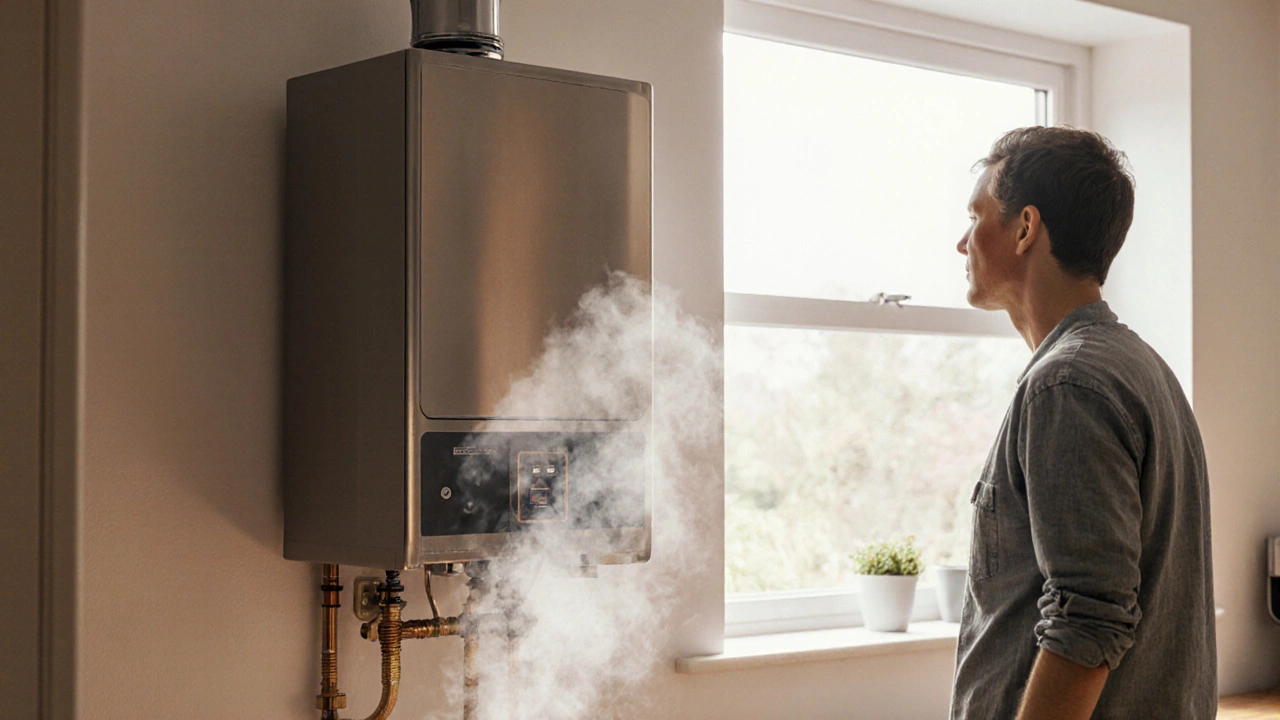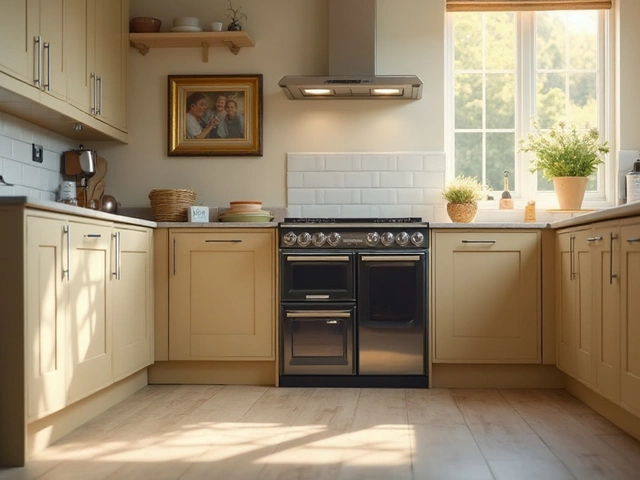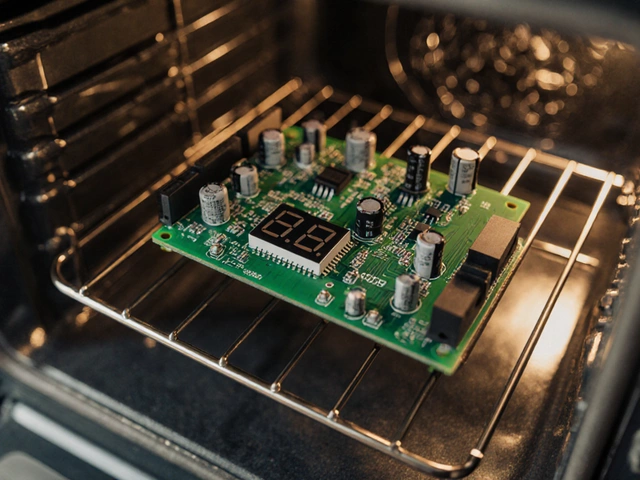Water Heater Warning Signs Checker
Strange Noises
Popping, rumbling, or hissing sounds
Rusty Water
Brown, orange, or red colored water
Hot Water Runs Out
Short supply of hot water
Pilot Light Issues
Flickering or blowing out pilot light
Leaks
Water pooling around the heater
Temperature Fluctuations
Water getting too hot or too cold
Select warning signs above and click "Analyze Warning Signs" to get personalized recommendations.
Quick Takeaways
- Strange noises, rusty water, or inconsistent hot water often mean the heater is on its last legs.
- Low hot‑water output, pilot light issues, and leaking are red flags that need immediate attention.
- Most problems stem from a faulty thermostat, a worn heating element, sediment buildup, or a leaky pressure‑relief valve.
- Simple checks like flushing the tank or testing the thermostat can buy you a few extra months.
- When in doubt, call a professional to avoid safety hazards and costly water damage.
How a Typical Water Heater Works
When a water heater is a device that heats water for household use, usually powered by gas or electricity, it follows a straightforward cycle:
- Cold water enters through the dip tube.
- The thermostat tells the heating element (electric) or gas burner (gas) when to fire.
- Heated water rises to the top of the tank and is drawn out when you turn on a tap.
- A pressure‑relief valve releases excess pressure to keep the system safe.
Understanding these parts helps you spot why a particular symptom appears.

Top Warning Signs Your Water Heater Is Going Bad
Below are the most common clues homeowners notice. If you see any of these, start troubleshooting right away.
| Sign | What It Usually Means |
|---|---|
| Strange noises (popping, rumbling) | Sediment buildup causing the heating element to overheat |
| Rusty or discolored water | Corroded dip tube or tank lining |
| Hot water runs out quickly | Thermostat stuck low or heating element failing |
| Pilot light keeps blowing out (gas models) | Dirty pilot assembly or faulty gas valve |
| Leaking at the bottom | Corroded tank or failed pressure‑relief valve |
| Temperature fluctuations | Malfunctioning thermostat |
| High energy bills | Heating element working harder due to scale or a failing thermostat |
Why These Signs Appear - The Root Causes
Each warning sign traces back to a specific component or condition:
- Sediment buildup: Hard water leaves mineral deposits at the bottom of the tank. When the heating element sits on this layer, it can overheat, causing the popping noises and reduced efficiency.
- Corroded dip tube: The dip tube delivers cold water to the bottom. If it cracks, cold water mixes with hot water earlier, leading to lukewarm showers and rusty runoff.
- Faulty thermostat: The thermostat regulates temperature. A stuck thermostat may keep the heater running too long (wasting energy) or shut it off too early (cold water).
- Leaking pressure‑relief valve: Designed to vent excess pressure. If the valve is worn, water can escape, creating puddles and potentially damaging flooring.
- Gas valve issues: In gas heaters, the valve controls the flow of gas to the burner. A faulty valve can cause the pilot light to sputter or go out completely.
What to Do When You Spot a Sign
Here’s a step‑by‑step guide for the most common problems. Remember, safety first - turn off power or gas before opening the unit.
- Check for noises: If you hear popping, turn off the heater and flush the tank. Open the cold‑water supply, attach a garden hose to the drain valve, and let water run until it’s clear.
- Inspect water colour: Run a glass of hot water. If it’s rusty, the tank may be corroding. Consider a replacement, especially if the heater is more than 10years old.
- Test hot‑water output: Time how long it takes to fill a bucket with hot water. If it’s under a minute for a full bucket, the thermostat or heating element likely needs replacement.
- Examine the pilot light (gas): If it flickers or goes out, clean the pilot assembly and check the gas valve for cracks. If you’re uncomfortable, call a licensed plumber.
- Look for leaks: Dry the area around the base. If water reappears, the tank may be rusting or the pressure‑relief valve is defective. Replace the valve or the entire unit if corrosion is extensive.
- Monitor temperature swings: Use a thermometer at the faucet. If the temperature jumps more than 20°C (35°F) within a few minutes, the thermostat is likely misreading.
- Check the energy bill: A sudden spike suggests the heater is working harder than usual, often due to scale or a failing element.

When to Call a Professional
DIY can fix many early‑stage issues, but some scenarios require a licensed technician:
- Extensive corrosion or tank leakage - the whole unit may need replacement.
- Gas‑related problems such as a faulty gas valve or persistent pilot‑light failures.
- Electrical faults like tripped breakers, burnt wiring, or a heating element that cannot be accessed safely.
- Repeated temperature fluctuations after thermostat replacement - could indicate wiring or control‑board issues.
Professional service not only ensures safety but also extends the lifespan of a new or repaired heater.
DIY Troubleshooting Checklist
- Turn off power/gas and water supply.
- Flush the tank to remove sediment.
- Inspect and clean the dip tube if visible.
- Test thermostat with a multimeter (if comfortable).
- Check pressure‑relief valve for proper discharge (lift lever gently).
- Run a full hot‑water cycle and note temperature consistency.
- Record any unusual sounds or smells for the technician.
Frequently Asked Questions
Why does my water heater make popping noises?
Popping usually means mineral sediment has built up at the bottom of the tank. When the heating element turns on, the water trapped under the scale flashes into steam, creating the noise. Flushing the tank often solves the issue.
Is rust-colored water a sign I need a new heater?
Rusty water indicates the tank interior is corroding. If the colour persists after a brief flush, the tank’s lifespan is likely over and replacement is the safest option.
What should I do if my gas water heater’s pilot light keeps blowing out?
First, turn off gas and let the unit cool. Clean the pilot assembly and check for drafts. If the problem continues, the gas valve may be defective and should be inspected by a licensed plumber.
How often should I flush my water heater?
For most Australian homes with moderate water hardness, flushing once a year is adequate. In hard‑water areas, consider every six months to keep efficiency high.
Can I replace just the thermostat instead of the whole heater?
Yes, if the heater is otherwise in good condition. Replacing a faulty thermostat can restore proper temperature control and save energy. Make sure the replacement part matches the manufacturer’s specifications.
If you’ve been watching for any of the water heater signs listed above, don’t wait until a burst pipe forces you into emergency repairs. A quick inspection or a professional tune‑up can keep your showers hot and your bills low for years to come.





